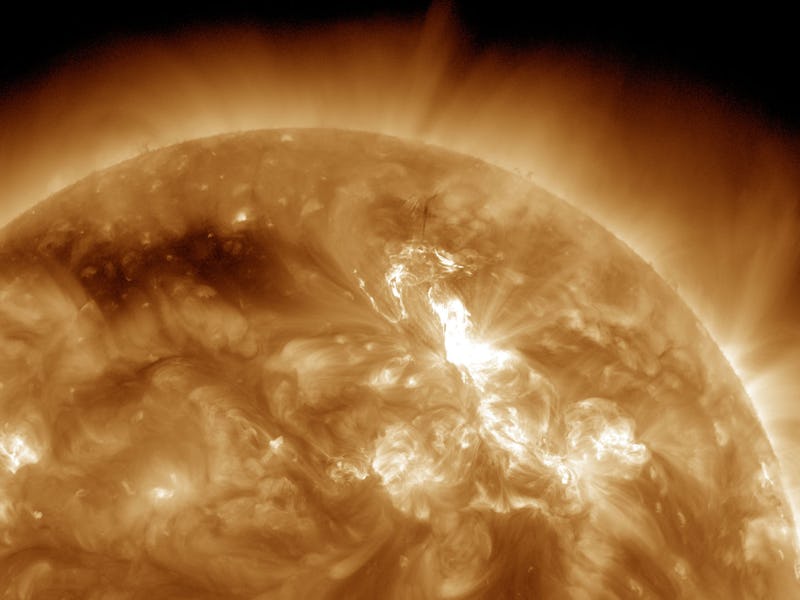What happens if a solar storm hits Earth?
How would our modern-day technology react to a geomagnetic storm?

On August 26, a flare-up erupted from the Sun and set off a “solar tsunami.”
This event sent a giant wave of hot particles flowing through the Solar System at speeds of up to 560 miles per hour, and some of it could reach Earth.
The latest wave of solar eruptions has some scientists worried that this may initiate a geomagnetic storm on Earth. But so far, the Earth is safe as the flareup turned out to be minor. However, these storms are hard to predict, and scientists still haven’t figured out what causes the Sun to erupt in these flareups.
If a geomagnetic storm were to occur today, it would likely destroy our navigation systems and underwater internet cables.
As scientists try to figure out what kind of solar storm the latest shockwave initiated, Inverse breaks down how the Sun works, why it sends hot plasma in our direction, and the effects of space weather on Earth.
How do solar storms affect Earth?
The Sun is an active star. Every now and then, a solar flare will erupt from the Sun and send a small ripple toward Earth's magnetic field.
A phenomenon related to flares called coronal mass ejections causes highly energetic eruptions from the Sun, providing the main source of major space weather events. These eruptions are essentially giant bubbles of gas and magnetic flux carrying up to a billion tons of charged particles, traveling at speeds of several million miles per hour.
The Sun erupts with hot plasma, some of which makes its way across the Solar System.
These clouds, and the shock waves they cause, occasionally reach Earth and cause geomagnetic storms.
Geomagnetic storms are major disturbances of Earth's magnetosphere — the space surrounding our planet governed by our magnetic field. The storms can often be observed as beautiful aurorae in our night sky, but they can also cause major disturbances in Earth’s power grids and navigation systems.
One of the last geomagnetic storms that had a major impact on Earth took place on August 7, 1972. A massive solar flare erupted from the Sun's surface, disrupting radio waves, telecommunication networks, and power systems by triggering an intense magnetic storm.
Is a solar storm about to hit Earth?
The forecast for the latest solar tsunami indicated that a geomagnetic storm may ensue, according to the recent forecast by the National Weather Service’s Space Weather Prediction Center.
But so far, the Earth is safe.
It was a C3-class solar flare, which is considered a minor solar flare with little to no effects on Earth. The solar flare launched a partial halo coronal mass ejection at a speed of about 500 kilometers per second, which is considered relatively slow, according to Space Weather.
But it created a partial halo coronal mass ejection headed towards Earth, with a minor chance of a geomagnetic storm.
What would happen on Earth if a storm got bad?
Solar flares sound scary, but they won’t exactly destroy the Earth.
The Sun’s occasional eruptions could reach our planet if they are especially powerful, and at that point may cause damage to power grids.
At the last SIGCOMM data communication conference held in late August, computer scientist Sangeetha Abdu Jyothi expressed concern that Earth’s modern-day power grids and large-scale internet cables would not be able to withstand a solar storm if it were to ever hit the planet.
Jyothi highlighted that underwater cables are not grounded well, and are therefore at risk of being damaged. Should a solar storm hit the Earth today, our GPS systems and satellites will likely be destroyed.
How often do solar storms occur?
Scientists have been studying the Sun for decades, and yet have still not been able to figure out what causes these storms to erupt or how to predict when the next solar storm will occur.
But NASA does keep a close eye on our Sun with satellites such as SOHO in case it decides to flare up in our direction, and ongoing missions headed towards the Sun such as the Parker Solar Probe will collect enough data on our host star to help scientists predict its behavior.
For now, scientists must observe our star closely should it decide to mess with our precious technology.